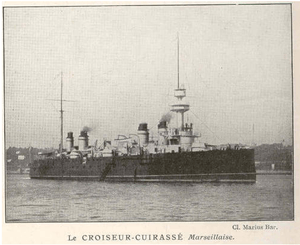French cruiser Marseillaise (1900)
 A print showing Marseillaise at anchor | |
| History | |
|---|---|
| Name: | Marseillaise |
| Namesake: | La Marseillaise |
| Builder: | Arsenal de Brest |
| Laid down: | December 1899 |
| Launched: | 14 July 1900 |
| Commissioned: | 1903 |
| Struck: | 1929 |
| Fate: | Broken up, 1933 |
| General characteristics | |
| Class and type: | Gloire-class cruiser armored cruiser |
| Displacement: | 9,534 metric tons (9,383 long tons) |
| Length: | 139.8 m (458 ft 8 in) |
| Beam: | 20.2 m (66 ft 3 in) |
| Draft: | 7.7 m (25 ft) |
| Installed power: |
|
| Propulsion: | 3 Shafts, 3 vertical triple-expansion steam engines |
| Speed: | 21 knots (39 km/h; 24 mph) |
| Range: | 12,000 nautical miles (22,000 km; 14,000 mi) at 10 knots (19 km/h; 12 mph) |
| Complement: | 612 |
| Armament: |
|
| Armor: |
|
The French cruiser Marseillaise was one of five Gloire-class armored cruisers built for the French Navy in the first decade of the 20th century. She served in the English Channel and the Atlantic as a convoy escort during World War I. She served as a gunnery training ship in 1925–29 and was broken up in 1933.
Design and description

The Gloire-class ships were designed as enlarged and improved versions of the Gueydon-class armored cruisers by Emile Bertin. Her crew numbered 612 officers and men.[1] The ship measured 139.8 meters (458 ft 8 in) overall, with a beam of 20.2 meters (66 ft 3 in). Marseillaise had a draft of 7.7 meters (25 ft 3 in)[2] and displaced 9,534 metric tons (9,383 long tons).[3]
The ship had three propeller shafts, each powered by one vertical triple-expansion steam engine, which were rated at a total of 20,500 indicated horsepower (15,300 kW). Twenty-four Belleville water-tube boilers provided steam for her engines. She had a designed speed of 21.5 knots (39.8 km/h; 24.7 mph).[2] She carried up to 1,590 long tons (1,620 t) of coal[1] and could steam for 12,000 nautical miles (22,000 km; 14,000 mi) at a speed of 10 knots (19 km/h; 12 mph).[2]
Marseillaise's main armament consisted of two 194-millimeter (7.6 in) guns were mounted in single gun turrets fore and aft. Her intermediate armament was eight Canon de 164 mm Modèle 1893 guns. Four of these were in single gun turrets on the sides of the ship and the other four were in casemates. For anti-torpedo boat defence she carried six 100-millimeter (3.9 in) guns in casemates and eighteen 47-millimeter (1.9 in) Hotchkiss guns. She was also armed with five 450-millimeter (17.7 in) torpedo tubes; two of these were submerged and the others were above water.[1]
The waterline armored belt of the Gloire-class ships was 170 millimeters (6.7 in) thick amidships and tapered to 106 millimeters (4.2 in) towards the bow and stern. Above the main belt was a thinner strake of armor, 127 millimeters (5 in) thick that also tapered to 106 mm at the ends of the ship.[4] The conning tower had armored sides 150 millimeters (5.9 in) thick. The main gun turrets were protected by 173 millimeters (6.8 in)[2] of armor and the intermediate turrets by 120 millimeters (4.7 in). The flat part of the lower armored deck was 45 millimeters (1.8 in), but increased to 64 millimeters (2.5 in) as it sloped down to the sides of the ship.[4]
Construction and career

Marseillaise, named after the French national anthem,[5] was laid down at the Arsenal de Brest in January 1900,[3] launched on 14 July 1900, and completed in 1903.[5] When World War I began, the cruiser was assigned to the Training Squadron which reinforced the 2nd Light Squadron at Brest.[6] She patrolled the English Channel into 1915, before she was transferred to the Caribbean and Atlantic for convoy-escort duties.[5]
In 1920, Marseillaise escorted SS George Washington as she ferried US President Woodrow Wilson to the USA.[7] The ship became a gunnery training ship in 1925–29 and was broken up for scrap in 1933.[5]
Notes
References
- "French Armored Cruiser Sully". Warship International. Toledo, Ohio: Naval Records Club. V (4): 324–26. 1968. ISSN 0043-0374.
- Gardiner, Robert, ed. (1979). Conway's All the World's Fighting Ships 1860–1905. Greenwich: Conway Maritime Press. ISBN 0-8317-0302-4.
- Moulin, Jean (2013). "France: La Marine Nationale". In O'Hara, Vincent. To Crown the Waves: The Great Navies of the First World War. Annapolis, Maryland: Naval Institute Press. ISBN 978-1-61251-269-3.
- Silverstone, Paul H. (1984). Directory of the World's Capital Ships. New York: Hippocrene Books. ISBN 0-88254-979-0.